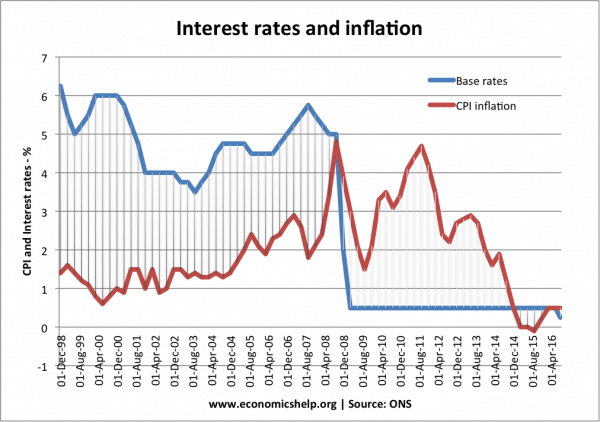
Definition of a liquidity trap: When monetary policy becomes ineffective because, despite zero/very low-interest rates, people want to hold cash rather than spend or buy illiquid assets.
A liquidity trap is characterised by
In the post-war period, there was no incidence of a liquidity trap in western economies (outside Japan). However, in 2008, the global credit crunch caused widespread financial disruption, a fall in the money supply and serious economic recession. Interest rates in Europe, the US and UK all fell to 0.5% – but the interest rate cuts were ineffective in causing economic activity to return to normal.

Example: Cut in interest rates in early 2009, failed to revive the economy.
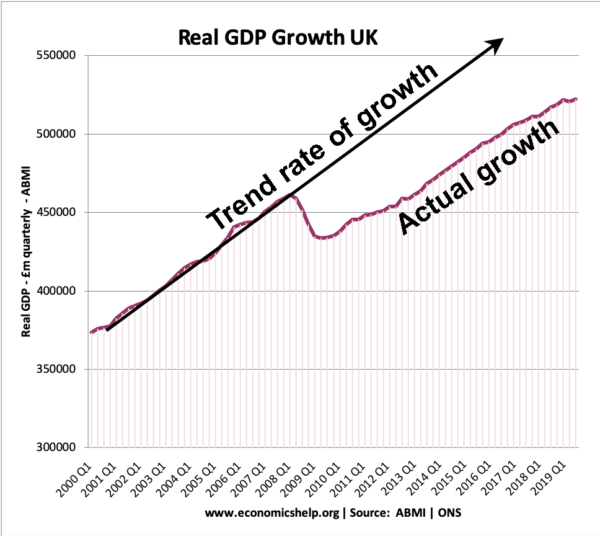
From 2009, economic growth in the UK was below the trend rate of economic growth – leading to lost real GDP.
A feature of a liquidity trap is that increasing the money supply has little effect on boosting demand. One reason is that increasing the money supply has no effect on reducing interest rates.

When interest rates are 0.5% and there is a further increase in the money supply, the demand for holding money in cash rather than investing in bonds is perfectly elastic.
This means that efforts to increase the money supply in a liquidity trap fail to stimulate economic activity because people just save more cash reserves. It is said to be like ‘pushing on a piece of string’
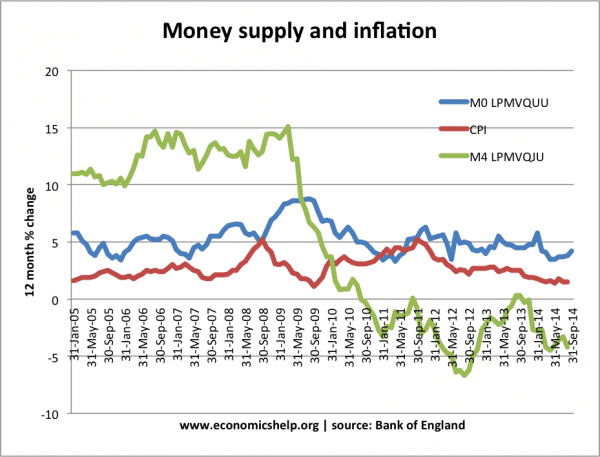
In the liquidity trap of 2009-15, there was a large increase in the monetary base (due to Quantitative easing) but the broad money supply (M4) showed little increase.
MO (monetary base) increased by over 7% in 2009 – but, it couldn’t stop the decline in M4.
Liquidity traps occur when there is a decline in economic activity, low confidence and unwilling by firms to invest. In more details

At the start of the credit crunch, there was a sharp rise in the UK saving ratio.
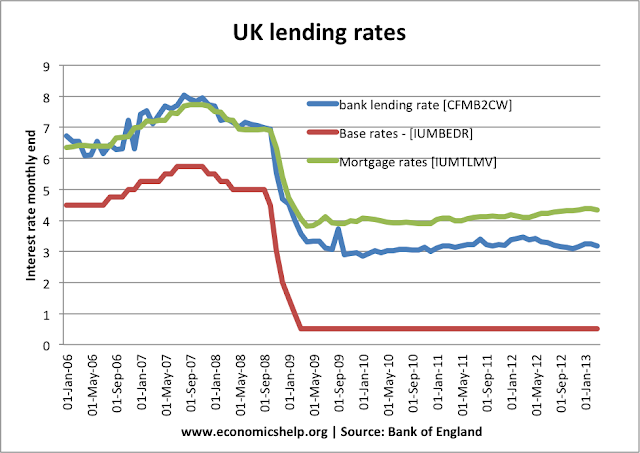
In a liquidity trap, commercial banks may not pass base rate onto consumers.
In 1936, Keynes wrote about a potential liquidity trap in his General Theory of Money
“There is the possibility…that, after the rate of interest has fallen to a certain level, liquidity-preference may become virtually absolute in the sense that almost everyone prefers cash to holding a debt which yields so low a rate of interest. In this event the monetary authority would have lost effective control over the rate of interest.”
The importance to Keynes was that if cutting interest rates wasn’t an option, the economy needed something else to get out of recession. His solution was fiscal policy. The government should borrow from the private sector (from surplus private sector savings) and then spend to kickstart the economy.
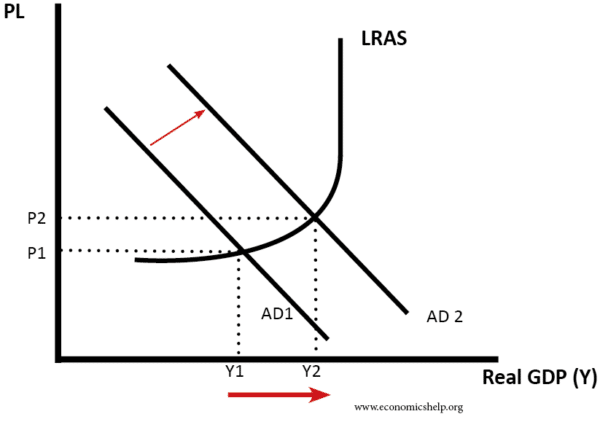
Expansionary fiscal policy leads to higher aggregate demand and economic growth – it also creates some inflation.
The argument is that the rise in private sector saving (which occurs in liquidity trap) needs to be offset by a rise in public borrowing. Thus government intervention can make use of the rise in private saving and inject spending into the economy. This government spending increases aggregate demand and leads to higher economic growth
Monetarists are more critical of fiscal policy. They argue that government borrowing merely shifts resources from the private sector to the public sector and doesn’t increase overall economic activity. They argue the increase in government borrowing will push up interest rates and crowd out private sector investment. They point to the experience of Japan in the 1990s where a liquidity trap was not solved by government borrowing and a ballooning public sector debt.
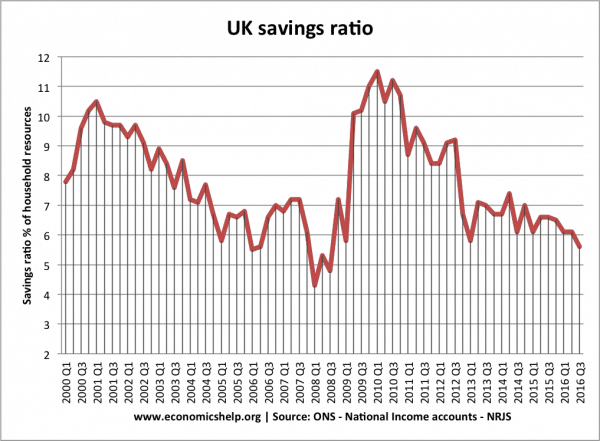
This shows the rapid rise in private sector saving in 2008/09.
Keynesians respond by saying, government borrowing may well cause crowding out in normal circumstances. But, in a liquidity trap, the excess rise in savings means that government borrowing won’t crowd out the private sector because the private sector resources are not being invested, but just saved. Resources are effectively idle. By stimulating economic activity the government can encourage the private sector to start investing and spending again (hence the idea of ‘crowding in’)
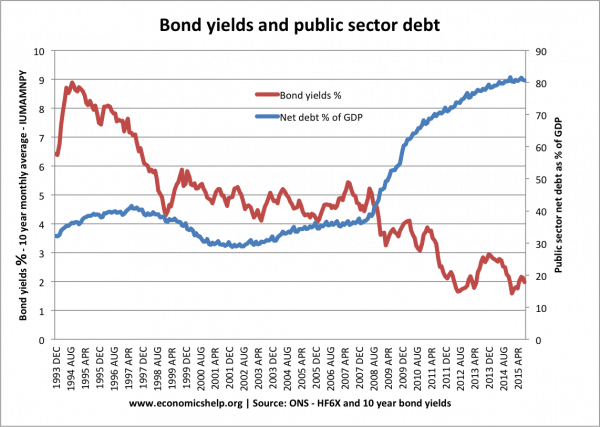
Also, Keynesians say that as well as expansionary fiscal policy, it is essential that governments / monetary authorities make a commitment to inflation. If expansionary fiscal policy occurs during periods of deflation it is likely to fail to boost overall aggregate demand. It is only when people expect a period of moderate inflation that real interest rates fall and the fiscal policy will be effective in boosting spending.
Modern monetary theory (MMT) argues that in a liquidity trap, the expansionary fiscal policy can be financed by an increase in the money supply and government borrowing is not needed. As long as inflation remains within an acceptable target, the government can print money to finance the spending.
Austrian economists. Ludwig Von Mises was critical of Keynes’ concept of a liquidity trap. He argued a fall in investment was caused by issues such as poor investment decisions, decline in productivity of investment and the business/productivity cycle.
Related
I’ve taken an interest in economics for forty years, and I’m sick to the back teeth of the Keynes versus monetarist argument. I suggest that when we want to stimulate our economy we go for a policy which involves both Keynsian and monetarist elements, i.e. a budget deficit which is not matched either by increased tax or government borrowing. This constitutes money printing, which is what has happened in 2009 in the guise of “Quantitative easing”. This policy is monetarist in that it increases the money supply. It is Keynsian in that it constitutes and injection, very much like an increase in exports. Whether it’s the money supply increase that does the real work or the Keynsian injection – well who cares as long as it works? Conversely, when we want to dampen economic activity with a view to controlling inflation we could (as well as raising interest rates) implement a budget surplus unmatched by tax or borrowing reductions. This equals “money extinguishing”.
backwardsevolutionSince the clowns who got us into this mess are “still” being rewarded (banks by hoarding reserves and by not being forced into bankruptcy) and the 0% down/no doc homeowners (who are allowed to stay in their homes without paying anything for up to 3 years), we have stagnation. Because banks are not releasing (or are slowly releasing) houses back onto the market, prices are being propped up artificially. This benefits the banks who don’t have to mark to market, and the homeowners. Helloooooo. How about trying something different. How about rewarding the people who didn’t take ridiculous risks because they knew the bubble was going to burst eventually? Why not raise interest rates for the savers (who didn’t partake in the merriment). This would force the homeowners out (who shouldn’t ever have been there in the first place), and would force the banks who took ridiculous risks out, making room for new banks who are fiscally prudent to come in. The savers, after receiving interest on their money, would begin to feel safer, and would begin to invest their hard-saved money. You’re trying to help the wrong people. The ones who would invest wisely are the savers (the ones who are being penalized right now). The idiots need to be weeded out. If you want a flower to grow, get rid of the weeds.
tamo francis ferdinandliquidity trap over-decrease in interest rate = over-decrease in investment or over-increase in saving
What type of fiscal and monetary policy is effective in case of a developing country in order to improve their GDP?
Comments are closed.
